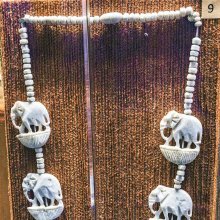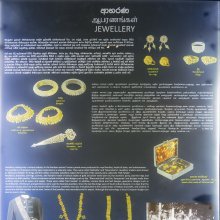Malai, Malaī, Maḻai, Māḻai, Māḷai: 9 definitions
Introduction:
Malai means something in Hinduism, Sanskrit, the history of ancient India, Marathi, Jainism, Prakrit, Hindi, biology, Tamil. If you want to know the exact meaning, history, etymology or English translation of this term then check out the descriptions on this page. Add your comment or reference to a book if you want to contribute to this summary article.
Images (photo gallery)
In Hinduism
Shilpashastra (iconography)
Source: Shodhganga: The significance of the mūla-beras (śilpa)Malai (“mountain”) refers to one of the several “attributes” (āyudha) or “accessories” of a detiy commonly seen depicted in Hindu iconography, defined according to texts dealing with śilpa (arts and crafs), known as śilpaśāstras.—The śilpa texts have classified the various accessories under the broad heading of āyudha or karuvi (implement), including even flowers, animals, and musical instruments. The other miscellaneous articles found as attributes in the hands of the deities are, for example, Malai.

Shilpashastra (शिल्पशास्त्र, śilpaśāstra) represents the ancient Indian science (shastra) of creative arts (shilpa) such as sculpture, iconography and painting. Closely related to Vastushastra (architecture), they often share the same literature.
India history and geography
Source: academia.edu: Minor Chiefs and "Hero" in Ancient TamilakamMalai (mountain, hill) is a name related to the historical geography and rulers of ancient Tamil Nadu, occuring in Sangam literature such as the Akanāṉūṟu and the Puṟanāṉūṟu.—Notes: (Ciṟumalai (Rajarajan 2019: fig. 2), kuṟiñci-tiṇai (cf. Sivathamby 1974, Devadevan 2006).)

The history of India traces the identification of countries, villages, towns and other regions of India, as well as mythology, zoology, royal dynasties, rulers, tribes, local festivities and traditions and regional languages. Ancient India enjoyed religious freedom and encourages the path of Dharma, a concept common to Buddhism, Hinduism, and Jainism.
Biology (plants and animals)
Source: Google Books: CRC World Dictionary (Regional names)Malai in India is the name of a plant defined with Spondias pinnata in various botanical sources. This page contains potential references in Ayurveda, modern medicine, and other folk traditions or local practices It has the synonym Spondias mangifera Willd. (among others).
Example references for further research on medicinal uses or toxicity (see latin names for full list):
· Genera Plantarum (1789)
· FBI (1876)
· Journal of Cytology and Genetics (1990)
· Hortus Bengalensis, or ‘a Catalogue of the Plants Growing in the Hounourable East India Company's Botanical Garden at Calcutta’ (1814)
· Planta Medica (1976)
· Supplementum Plantarum (1781)
If you are looking for specific details regarding Malai, for example pregnancy safety, health benefits, extract dosage, diet and recipes, side effects, chemical composition, have a look at these references.

This sections includes definitions from the five kingdoms of living things: Animals, Plants, Fungi, Protists and Monera. It will include both the official binomial nomenclature (scientific names usually in Latin) as well as regional spellings and variants.
Languages of India and abroad
Marathi-English dictionary
Source: DDSA: The Molesworth Marathi and English Dictionarymalaī (मलई).—f (malla Wrestler.) Noise and bluster, clamor and rudeness, the overbearing (as resorted to by persons overcome in argument) by manual violence or furious vociferation. v kara, māṇḍa, mājava. 2 Boisterous and tumultuous proceedings (of any assembly or concourse). Ex. dakṣiṇā ghētē vēḷēsa ma0 kēvaḍhī! pōrāñcī ma0 cālalī. 3 Any disorderly and promiscuous gathering of persons (as of all castes, of sōvaḷē & ōvaḷē &c.) Hence 4 Applied to an inn, eating house, cook's shop &c.
--- OR ---
malaī (मलई).—f ( H) Cream.
--- OR ---
malāī (मलाई).—f ( H) Cream.
--- OR ---
maḷaī (मळई).—f (maḷa) Mud and garbage brought by rains or the river, alluvial depositions. 2 The garden or plantation thereon. 3 A seine or large fishing net. 4 (Preferably malaī) Cream.
Source: DDSA: The Aryabhusan school dictionary, Marathi-Englishmalaī (मलई).—f Noise and bluster. Any disorder- ly gathering of persons. Inn.
--- OR ---
malaī (मलई).—f Cream.
--- OR ---
maḷaī (मळई).—f Alluvial depositions. (maḷakī) A large fishing-net.
Marathi is an Indo-European language having over 70 million native speakers people in (predominantly) Maharashtra India. Marathi, like many other Indo-Aryan languages, evolved from early forms of Prakrit, which itself is a subset of Sanskrit, one of the most ancient languages of the world.
Hindi dictionary
Source: DDSA: A practical Hindi-English dictionaryMalāī (मलाई):—(nf) cream; —[utāranā] to defend flatteringly, to cover the drawbacks of (as an effort to flatter).
...
Prakrit-English dictionary
Source: DDSA: Paia-sadda-mahannavo; a comprehensive Prakrit Hindi dictionaryMālai (मालै) in the Prakrit language is related to the Sanskrit word: Mālatī.
Prakrit is an ancient language closely associated with both Pali and Sanskrit. Jain literature is often composed in this language or sub-dialects, such as the Agamas and their commentaries which are written in Ardhamagadhi and Maharashtri Prakrit. The earliest extant texts can be dated to as early as the 4th century BCE although core portions might be older.
Nepali dictionary
Source: unoes: Nepali-English DictionaryMalāī (मलाई):—n. cream; milk cream;
Nepali is the primary language of the Nepalese people counting almost 20 million native speakers. The country of Nepal is situated in the Himalaya mountain range to the north of India.
See also (Relevant definitions)
Starts with (+277): Malai antimalli, Malai inci, Malai maithra, Malai marukoluntu, Malai tagarai, Malai tikus, Malai vasambu, Malai vembu, Malai vempu, Malai-akalam, Malai-anpiramanar, Malai-atipati, Malai-atthi, Malai-carkkaraivalli, Malai-icham, Malai-ichchi, Malai-k-konrai, Malai-k-koyya, Malai-kalirul, Malai-kaliruttu.
Ends with (+220): Aciriyamalai, Akkamalai, Alaimalai, Alakukamalai, Alarkamalai, Amalai, Amalaicomalai, Ampikaimalai, Ankamalai, Annamalai, Antimalai, Anurakamalai, Araimalai, Ataimalai, Atcamalai, Atumalai, Avinantamalai, Caiyamalai, Camalai, Cantira-kavi-urumalai.
Full-text (+656): Malaikkarar, Malati, Verrimalai, Malaikkuli, Malaimacankal, Malaippatikam, Malaippan, Malaiputtal, Perumalai, Malaiyanti, Vakumalai, Muttu-malaikuruvai, Varakimalai, Muttumalai, Ven-punarccimalai, Vacamalai, Cattumalai, Caramalai, Nallamalai, Karrumalai.
Relevant text
Search found 16 books and stories containing Malai, Malaī, Malāī, Maḷaī, Mālai, Mālai°, Mālaī, Maḻai, Māḻai, Māḷai, Mazhai, Maazhai, Maalai; (plurals include: Malais, Malaīs, Malāīs, Maḷaīs, Mālais, Mālai°s, Mālaīs, Maḻais, Māḻais, Māḷais, Mazhais, Maazhais, Maalais). You can also click to the full overview containing English textual excerpts. Below are direct links for the most relevant articles:
Tiruvaymoli (Thiruvaimozhi): English translation (by S. Satyamurthi Ayyangar)
Pasuram 4.3.4 < [Section 3 - Third Tiruvaymoli (Kovai Vayal)]
Pasuram 10.4.11 < [Section 4 - Fourth Tiruvaymoli (Carve tavanori)]
Pasuram 2.7.13 < [Section 7 - Seventh Tiruvaymoli (kecavan tamar)]
A History of Indian Philosophy Volume 3 (by Surendranath Dasgupta)
Part 1 - The Chronology of the Āḻvārs < [Chapter XVII - The Āḻvārs]
Part 5 - The Influence of the Āḻvārs on the followers of Rāmānuja < [Chapter XVIII - An Historical and Literary Survey of the Viśiṣṭādvaita School of Thought]
Part 1 - The Aḻagiyas from Nāthamuni to Rāmānuja < [Chapter XVIII - An Historical and Literary Survey of the Viśiṣṭādvaita School of Thought]
'The Heroic Mother' < [December 1938]
Tamil Poetry since Independence < [April 1963]
Jewish Vision in “More Die of Heartbreak” < [January – March, 1993]
Later Chola Temples (by S. R. Balasubrahmanyam)
Temples in Narttamalai < [Chapter XVI - Temples of Rajendra III’s Time]
Chapter III - Vikrama Chola (a.d. 1118-1135)
Sanskrit sources of Kerala history (by Suma Parappattoli)
The Trivandrum Huzur plates of Ko-Karunantadakkar < [Chapter 1 - Historical details from Sanskrit Inscriptions]
The Religion and Philosophy of Tevaram (Thevaram) (by M. A. Dorai Rangaswamy)
Nayanar 12: Manakanchara (Manakkancarar) < [Volume 4.1.1 - A comparative study of the Shaivite saints the Thiruthondathogai]
Nayanar 5: Meiporul (Meypporul) < [Volume 4.1.1 - A comparative study of the Shaivite saints the Thiruthondathogai]
Chapter 2.3 - Partha-anugraha-murti (depiction of the story of Arjuna) < [Volume 2 - Nampi Arurar and Mythology]

